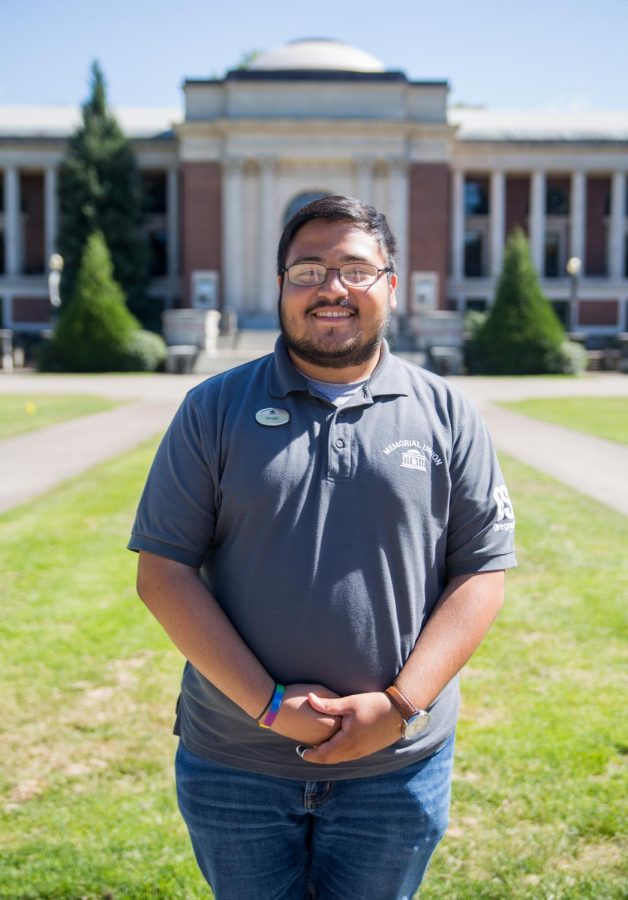Position in transition
July 31, 2017
In recent years, changes in the Memorial Union organization have raised questions regarding whether or not the title of MU president still fits the role. According to the MU website, the purpose of the MU is to act as a hub for the social side of the student experience by providing facilities, resources and events throughout the year. To keep the MU aligned with the student body it serves, the organization annually elects a student president who also oversees the MU Advisory Board. This year, however, the title has been placed under evaluation to determine if ‘board chair’ would be a better fit for the position.
“We’re looking into shifting the names just because there’s a shift in the organization, so a shift in the names should be good,” said current MU president, Angel Mandujano-Guevara. “Right now, though, my job entails providing leadership for programs and policies that go on in the MU, and keeping students at the center.”
Mandujano-Guevara was selected to become the MU president in the spring of 2017. Mandujano-Guevara is a fourth-year student looking to complete a dual degree in English and education. Before entering his current role as MU President, Mandujano-Guevara worked with Movimiento Estudiantil Chicanx de Aztlán (MEChA) de OSU at both the regional and national level. According to Mandujano-Guevara, MEChA is a national student organization that promotes the history, culture and higher education for Chicanx youth.
According to Mandujano-Guevara, he looks forward to applying his past experience in student engagement within the MU.
“It’s been more of seeing what past presidents have done and seeing what I want to do,” Mandujano-Guevara said. “Really exploring what the position is, how it can be of use to the MU organization and how I can work with the directors to bring forth more student representation or more student involvement within the MU.”
This ability to connect with more students through the MU is one of the reasons Mandujano-Guevara was drawn to the position. According to Mandujano-Guevara, he had interacted with the previous MU president Rafid Chowdhury at several committee meetings and felt inspired to apply for the position when the opportunity arose.
“I wanted to see the next step I could take to get involved on campus, increasing the scope of students I would eventually reach,” Mandujano-Guevara said. “I want to have a lot more connection with student and faculty programs—so being able to have partnerships with groups like the Faculty Senate and the different colleges.”
Kent Sumner, the associate director of OSU’s Division of Student Affairs Communications, is one of the faculty members working with Mandujano-Guevara. Sumner has worked with the MU for over 20 years promoting and marketing events. He has also assisted past MU presidents with planning various activities throughout the year.
“We interact with a lot of departments within Student Affairs, the MU being one of them,” Sumner said. “Over the years, I have worked with MU presidents as they have planned events or need help promoting services or activities.”
During his time working with the MU, Sumner has witnessed a variety of changes. Groups that were initially extensions of the MU—the OSU Program Council; Orange Media Network, of which The Barometer is a part; and others—became independent entities. According to Sumner, this separation has allowed the MU administration, including the president and board, to focus their efforts on serving the student body.
“The MU president was more involved in events that the OSU Program Council puts on, and OSUPC did not have its own director as it does now,” Sumner said. “There’s still that connection, though, because the director of OSUPC sits on the advisory board for the MU. So there’s still a tie in, there’s just better defined roles.”
One of the people within the MU helping to better define the president’s role is the MU Associate Director and Food Service Director Robyn Jones. Jones has worked within the organization for more than 20 years handling the retail side of food at OSU. Her position involves overseeing the dining retail facilities on campus that are not directly run by University Housing and Dining Services, and she has worked closely with past MU presidents to actualize their goals. Jones also participated in many of the MU Advisory Board meetings last year, where she was able to develop further insight into the shift in title.
“This will be a year of inquiry for the MU Advisory Board,” Jones said in an email. “The board has been charged with determining the appropriate title based on the current needs of the organization—the requirements of the Student Incidental Fees Committee and duties required.”
Changes like these have been sweeping all across campus in recent years, according to Sumner. He pointed towards an increasing student population as a cause for these shifts in administration within the MU and elsewhere.
“To serve more students will few staff means they have to do their work differently and they have multiple roles,” Sumner said in an email. “Since students are filling more of the positions, including building and restaurant management, it also means that their roles have changed.”
Some of the positions now filled by these students exist in the MU advisory board. Thirteen of the 19 members of the board are students, from the ASOSU president to MU student employees.
Mandujano-Guevara said he looks forward to the opportunity to make both himself and the entire MU more accessible to students.
“I don’t see it much as a change,” Mandujano-Guevara said. “I see it as more of a developing and an ability to have a good representation of student life here on campus.”











































































































